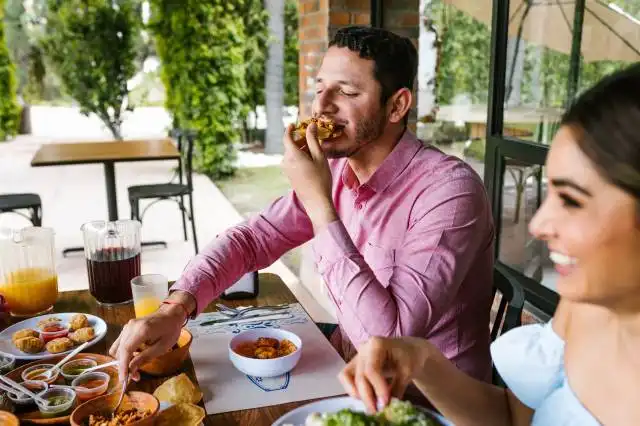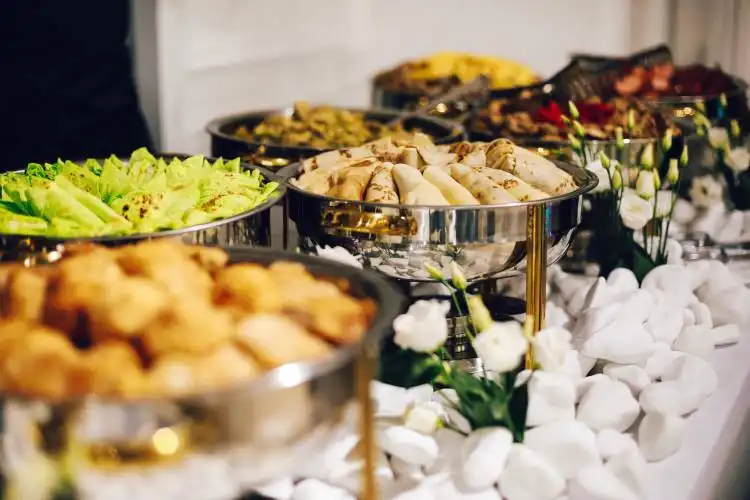Start a Carryout Restaurant
Serving the World Your Signature Dishes: The Wooing Power of a Carryout Restaurant
| Updated


CARRYOUT RESTAURANT
Have you ever dreamed of serving your favorite dishes hot and ready-to-go? Then owning a carryout restaurant might just be the recipe to satisfy your entrepreneurial cravings. A carryout restaurant caters to the demand of diners who are always on the move by offering delicious food that's packed and ready to be enjoyed elsewhere. With a focus on speed, quality, and convenience, your carryout restaurant can be a hit among busy workers, families looking for an easy meal solution or individuals who prefer dining in their favorite spots.
Jump to Business Plan
RELATED BUSINESS IDEAS
Browse ALL Food & Beverage Entrepreneurship Business Ideas
Discover Your Perfect Domain
Unlock the door to your online success with our hand-picked selection of premium domain names. Whether you're starting a new venture or rebranding an existing one, the right domain can set the tone for your digital presence. Browse through our curated list, each with its unique potential to enhance your brand's visibility and credibility.
CARRYOUT RESTAURANT MINI BUSINESS PLAN
This a quick reality check to help you identify the strengths and weaknesses of your business concept before you dive in.
Expected Percent Margin:
- Gross Margin: 60-70%
- Net Profit Margin: 15-20%
Earnings Expectations:
- Daily Earnings: $400 - $800
- Weekly Earnings: $2,800 - $5,600
- Monthly Earnings: $12,000 - $24,000
- Annual Earnings: $144,000 - $288,000
Actions Needed to Achieve These Numbers:
Food Cost and Inventory Management:
- Initial Investment: Approximately $5,000 - $25,000 for initial inventory and equipment purchase.
- Food Cost Control: Aim to keep food costs around 30-35% of revenue.
Marketing and Public Relations:
- Social Media Marketing: Post delectable pictures and daily specials; interact with your customers frequently.
- Local Advertising: Collaborate with local influencers or bloggers to review your food.
Operations and Customer Service:
- Staff: Hire skilled cooks and friendly, efficient front-of-house staff.
- Operating Days: Aim to operate the business 6-7 days a week.
Cost Control:
- Rent and Overhead: Select a location where rent and utility costs are less than 10% of projected monthly revenue.
- Supply Chain Management: Establish good relationships with local food suppliers, negotiate for best possible rates while ensuring quality.
Sales Targets:
- Average Ticket Price: Keep the average per-person ticket to around $10-$12.
- Transaction Volume: Aim to serve 40-60 customers per day to start, increasing this as the restaurant's reputation grows.
Remember, these are estimations and actual results can vary based on your location, the economy, and individual business strategies. Always work with a business financial advisor for personalized advice.
NOT WHAT YOU HAD IN MIND? Here are more ideas



Browse ALL Food & Beverage Entrepreneurship Business Ideas
Grab Your Business Website Name
Before you get caught up in the whirlwind of setting up your business, invest in a domain name. It's a small but significant step that lays the foundation for your brand and makes it easier for customers to find and trust you. Just like you wouldn't build a house without securing the land first, don't build a business without securing your domain name.
"Why? Can't that wait?" Here's why it shouldn't
Step 1: Determine if the Business is Right Endeavor
Breakdown of Startup Expenses
Before starting a carryout restaurant, it is important to understand the startup costs associated with the business. This includes the cost of renting a space, purchasing equipment, hiring staff, and obtaining permits. Additionally, there may be costs associated with marketing and advertising, such as creating a website or purchasing ads. It is important to research the costs associated with each of these items and create a budget that will cover all of the necessary expenses.
Breakdown of Ongoing Expenses
In addition to the startup costs, there are also ongoing expenses associated with running a carryout restaurant. This includes the cost of food, supplies, utilities, and payroll. It is important to research the cost of each of these items and create a budget that will cover all of the necessary expenses. Additionally, it is important to factor in the cost of any repairs or maintenance that may be needed in order to keep the restaurant running smoothly.
Examples on Ways to Make Money
Once the startup and ongoing expenses have been determined, it is important to consider ways to make money. This includes offering discounts, creating loyalty programs, and offering delivery services. Additionally, it is important to consider ways to market the restaurant, such as creating a website, using social media, and advertising in local publications. It is important to research the most effective ways to market the restaurant and create a plan that will help to increase sales and profits.
Step 2: Name the Business
Choosing the right name for your carryout restaurant is an important step in the process of starting a business. It should be something that is memorable and easy to pronounce. It should also be something that reflects the type of food you will be serving. Consider using a combination of words that describe the type of food you will be serving, such as “Tasty Takeout” or “Carryout Cuisine.” You may also want to consider using a play on words or a pun to make your name stand out. Additionally, you should make sure that the name you choose is not already being used by another business. Do your research and make sure to check with your local government to make sure the name you choose is available.
Tips on How to Register the Name
Once you have chosen the name for your carryout restaurant, you will need to register it with your local government. This will ensure that no one else can use the same name for their business. You will need to fill out the appropriate paperwork and pay any associated fees. Additionally, you may need to register the name with the United States Patent and Trademark Office if you want to protect it from being used by someone else. This will ensure that your business name is legally protected.
Step 3: Create a Business Plan
Creating a business plan is essential for any business, especially a carryout restaurant. A business plan should include a mission statement, a description of the business, a market analysis, a description of the products and services offered, a description of the management team, a financial plan, and a description of the marketing strategy. Additionally, the business plan should include a timeline for the business launch, a list of competitors, and a list of any potential risks.
Tips for Writing a Business Plan
When writing a business plan, it is important to be as detailed as possible. Include information on the target market, the menu, the pricing, the location, the hours of operation, the staffing requirements, and the marketing strategy. Additionally, include a financial plan that outlines the startup costs, the ongoing costs, and the expected revenue. Finally, make sure to include a timeline for the business launch and a list of any potential risks.
Step 4: Obtain Licenses and Permits
In order to start a carryout restaurant, there are a few types of licenses and permits that must be obtained. Depending on the location, the types of licenses and permits needed may vary. Generally, a business license, health permit, and food service license are required. Additionally, a liquor license may be necessary if the restaurant will be serving alcohol. It is important to research the local regulations and laws in order to determine what types of licenses and permits are required.
How to Apply for Licenses and Permits
Once the types of licenses and permits needed have been determined, the next step is to apply for them. This process can be done online or in person. Depending on the location, the process may take anywhere from a few days to a few weeks. Additionally, there may be a fee associated with the application process. It is important to research the local regulations and laws in order to determine the exact process and fees associated with obtaining the necessary licenses and permits.
Benefits of Obtaining Licenses and Permits
Obtaining the necessary licenses and permits is an important step in starting a carryout restaurant. Having the proper licenses and permits will ensure that the restaurant is in compliance with all local regulations and laws. Additionally, having the proper licenses and permits will help to protect the business from any potential legal issues. Furthermore, having the proper licenses and permits will help to build credibility and trust with customers.
Step 5: Find a Location
Finding the right location for a carryout restaurant is essential. When choosing a location, there are several factors to consider. First, the location should be easily accessible to customers. It should also be in a safe area with plenty of foot traffic. Additionally, the location should have enough space to accommodate the restaurant’s needs, such as seating and storage. Finally, the rent should be affordable and within the restaurant’s budget.
Research the Local Competition
Once a potential location has been identified, it’s important to research the local competition. This includes researching the types of food they offer, their prices, and their customer service. This research will help the restaurant determine what makes them unique and how they can stand out from the competition. Additionally, it will help the restaurant determine what types of food they should offer and what prices they should charge.
Secure the Location
Once the restaurant has identified a location and researched the local competition, it’s time to secure the location. This includes signing a lease agreement and paying the necessary fees. Additionally, the restaurant should make sure that the location meets all local health and safety regulations. Finally, the restaurant should make sure that the location has all the necessary utilities, such as electricity and water.
Step 6: Design the Restaurant
When designing the restaurant, there are many elements to consider. First, the layout of the restaurant should be well thought out. This includes the placement of tables and chairs, the kitchen area, the bar area, and the restrooms. Additionally, the restaurant should have a unique and inviting atmosphere. This can be achieved through the use of colors, lighting, and decorations. It is also important to consider the type of furniture and fixtures that will be used. For example, if the restaurant is going to be a casual dining establishment, then the furniture should be comfortable and inviting. On the other hand, if the restaurant is going to be a fine dining establishment, then the furniture should be more formal and luxurious.
Hiring a Professional
It is also important to consider hiring a professional to help with the design of the restaurant. A professional can help to create a design that is both aesthetically pleasing and functional. They can also help to ensure that the design meets all local building codes and regulations. Additionally, a professional can help to create a design that is both cost-effective and energy-efficient. Finally, a professional can help to ensure that the design is both safe and comfortable for customers and employees.
Step 7: Hire Employees
Finding the right employees is essential for the success of a carryout restaurant. The best way to find the right employees is to post job openings on job boards and websites, such as Indeed and Monster. Additionally, it is important to create a job description that outlines the duties and responsibilities of the position. This will help to ensure that the right people are hired for the job. Additionally, it is important to conduct background checks and interviews to ensure that the right people are hired.
Training Employees
Once the right employees have been hired, it is important to provide them with the necessary training. This includes providing them with the necessary information about the restaurant, such as the menu, the hours of operation, and the policies and procedures. Additionally, it is important to provide employees with the necessary safety training, such as food safety and sanitation. Additionally, it is important to provide employees with customer service training to ensure that they are able to provide the best possible service to customers.
Establishing Policies and Procedures
It is important to establish policies and procedures for employees to follow. This includes establishing rules for employees to follow, such as dress code, attendance, and customer service. Additionally, it is important to establish policies and procedures for handling customer complaints and resolving disputes. This will help to ensure that employees are able to provide the best possible service to customers.
Establishing a Pay Structure
It is important to establish a pay structure for employees. This includes setting an hourly wage and establishing a bonus structure for employees who go above and beyond. Additionally, it is important to establish a system for tracking employee hours and ensuring that employees are paid on time. This will help to ensure that employees are properly compensated for their work.
Step 8: Purchase Equipment
When starting a carryout restaurant, it is important to purchase the right equipment. This includes items such as a commercial oven, refrigerator, freezer, and dishwasher. It is also important to purchase items such as a cash register, tables, chairs, and dishes. Additionally, you will need to purchase items such as a food processor, a blender, and a mixer. Finally, you will need to purchase items such as a deep fryer, a griddle, and a stove.
Where to Purchase
When purchasing equipment for a carryout restaurant, it is important to shop around for the best prices. Many restaurant supply stores offer discounts on bulk orders, so it is important to take advantage of these deals. Additionally, it is important to look for used equipment, as this can save you a lot of money. You can also purchase equipment from online retailers, such as Amazon or eBay. Finally, you can purchase equipment directly from the manufacturer, which can often be the most cost-effective option.
Installation
Once you have purchased the necessary equipment for your carryout restaurant, it is important to have it installed correctly. Many restaurant supply stores offer installation services, so it is important to take advantage of this. Additionally, you can hire a professional to install the equipment for you. This is especially important for items such as a commercial oven, as it can be dangerous to install it yourself. Finally, you may be able to install some of the equipment yourself, such as a cash register or a blender.
Step 9: Market the Restaurant
When it comes to marketing a carryout restaurant, it is important to think outside the box. Traditional advertising methods such as print ads, radio spots, and television commercials can be effective, but they can also be expensive. Social media is a great way to reach a large audience without breaking the bank. Utilizing platforms such as Facebook, Twitter, and Instagram to post pictures of your food, specials, and events can be a great way to build a loyal customer base. Additionally, creating a website and utilizing SEO tactics can help to drive organic traffic to your restaurant.
Tips for Creating a Successful Marketing Plan
Creating a successful marketing plan is essential for any business, especially a carryout restaurant. Start by researching your target market and creating a plan to reach them. Consider the types of media they use, the type of content they respond to, and the best way to reach them. Additionally, create a budget for your marketing efforts and stick to it. Lastly, track the results of your marketing efforts to ensure that they are effective.
EXPLORE MORE CATEGORIES
Browse ALL Business Idea Categories
TAKE THE NEXT STEPS










